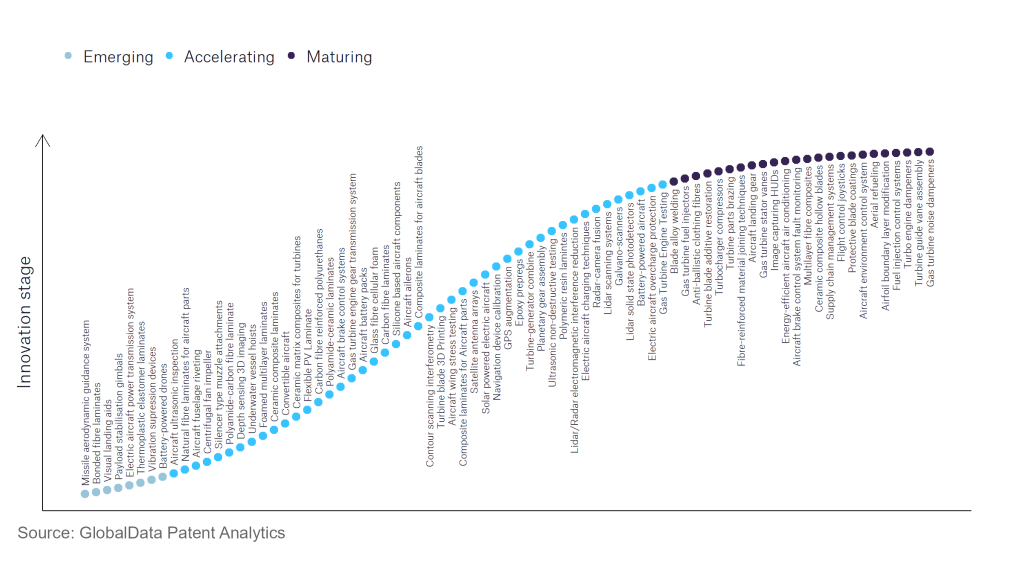The aerospace and defence industry continues to be a hotbed of innovation, with activity driven by the uptake of advanced technology, and the growing importance of technologies such as hypersonics and advanced materials.
In the last three years alone, there have been over 174,000 patents filed and granted in the aerospace and defence industry, according to GlobalData’s report on Innovation in Aerospace, Defence & Security: Battery-powered aircraft.
However, not all innovations are equal and nor do they follow a constant upward trend. Instead, their evolution takes the form of an S-shaped curve that reflects their typical lifecycle from early emergence to accelerating adoption, before finally stabilising and reaching maturity.
Identifying where a particular innovation is on this journey, especially those that are in the emerging and accelerating stages, is essential for understanding their current level of adoption and the likely future trajectory and impact they will have.
180+ innovations will shape the aerospace and defence industry
According to GlobalData’s Technology Foresights, which plots the S-curve for the aerospace and defence industry using innovation intensity models built on over 262,000 patents, there are 180+ innovation areas that will shape the future of the industry.
Within the emerging innovation stage, hydrogen fuel cells, contrarotating propeller spinners, and fuel cells for aircraft are disruptive technologies that are in the early stages of application and should be tracked closely.
EV charging stations, collapsible aircraft wings and electric aircraft charging interfaces are some of the accelerating innovation areas, where adoption has been steadily increasing. Among maturing innovation areas are fuselage frame modelling and powered wheels for aircraft landing, which are now established in the industry.
Innovation S-curve for the aerospace and defence industry

Battery-powered aircraft is a key innovation area in aerospace and defence
An overcharge protection circuit protects a battery and disconnects power as necessary.
GlobalData’s analysis also uncovers the companies at the forefront of each innovation area and assesses the potential reach and impact of their patenting activity across different applications and geographies.
According to GlobalData, there are 20+ companies, spanning technology vendors, established aerospace and defence companies, and up-and-coming start-ups engaged in the development and application of electric aircraft overcharge protection.
Key players in electric aircraft overcharge protection – a disruptive innovation in the aerospace and defence industry
‘Application diversity’ measures the number of different applications identified for each relevant patent and broadly splits companies into either ‘niche’ or ‘diversified’ innovators.
‘Geographic reach’ refers to the number of different countries each relevant patent is registered in and reflects the breadth of geographic application intended, ranging from ‘global’ to ‘local’.
Patent volumes related to electric aircraft overcharge protection
SZ DJI Technology is the largest company in this sector. The company is mainly known for manufacturing a variety of drones for industrial purposes and the patent filings are designed to protect the battery circuits of electric-powered drones.
Whilst this technology is on a relatively small scale, it has the potential to be applied to the larger battery systems of electric aircraft. Hyundai Motor Group is the second largest patent filer in the sector, the company is developing an eVTOL and the overcharge protection circuit is being patented to directly develop this and other electric aircraft solutions.
In terms of application diversity, SoftBank Group is top, followed by Alarmcom and Loon. By geographic reach, Nileworks is top, followed by Safran and Wing Aviation.
This technology is critical to the development of electric aircraft, and patent activity will increase as more companies invest in the sector.
To further understand the key themes and technologies disrupting the aerospace and defence industry, access GlobalData’s latest thematic research report on Defence.
GlobalData, the leading provider of industry intelligence, provided the underlying data, research, and analysis used to produce this article.
GlobalData’s Patent Analytics tracks patent filings and grants from official offices around the world. Textual analysis and official patent classifications are used to group patents into key thematic areas and link them to specific companies across the world’s largest industries.